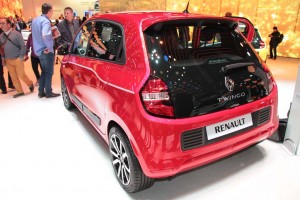There’s a big car inside the little Renault Twingo making its debut at the Geneva Motor Show this year – and it offers some significant hints as to what’s to come when Smart unveils its own new minicar, the Forfour, later in 2014.
The two vehicles were developed as part of an expanding alliance pairing the French automaker and Smart’s German parent Daimler AG – along with Renault’s Japanese partner Nissan. The three makers are jointly developing an array of vehicles, from microcars to compact luxury models.
The new Twingo is more than just a modest redesign. Working with Smart, Renault made some radical changes – starting with the decision to mount the engine in the rear, a strategy that offers a number of advantages, contends Benoit Bochard, the program’s product planning chief. Among other things, it helped engineers move the front axle forward, yielding significantly more space for both passengers and cargo.
Without an engine up front to constrict the suspension, meanwhile, the new Twingo has a far smaller turning circle, even better suited to maneuvering around tight European city streets.
Downsizing was a key goal, both for maneuverability but also for fuel economy, without making owners sacrifice room and comfort. Spend any time in the back seat and you’re likely to accept Bochard’s claim that the new Twingo is “a real 4-seater,” certainly when compared to the outgoing model.
(Small is big with the new Jeep Renegade. Click Here to check out its Geneva Motor Show debut.)
The Twingo, incidentally, is not just the only rear-engine model in its segment — and one of the few on the market outside of exotic sports cars like the Porsche 911 – but the only one Renault has built since the post-War 4CV.
The new minicar will be offered with two powertrain options after its late summer launch. There’s a 71 horsepower 3-cylinder model displacing 1.0-liter, and a turbocharged version of the little engine – downsized to 0.9-liters – turning out 90 hp.
(Alfa goes topless with 4C Spider. Click Here for a closer look.)
Surprisingly, Renault is dropping its diesel option – a recognition, says Bochard, of market demands in the microcar segment, along with changing government regulations. New European rules are tightening diesel standards on both particulates and oxides of nitrogen and the added cost of meeting those mandates just can’t be justified by the additional mileage.
Renault has yet to set pricing, though look for it to be quite close to that of the outgoing Twingo. Meanwhile, fuel economy should be better, according to Renault.
The Twingo will be one of the first visible results from the expanding alliance between Renault, Nissan and Daimler AG. Future products will include some Infiniti compact luxury models sharing the same platform as the recently introduced Mercedes-Benz CLA.
But next on tap is the Smart Forfour, a much-needed four-seater that is expected to be unveiled later in 2014, possibly at the Paris Motor Show in October.
“There will be no visible common parts,” notes Bochard, though the two will share “hard points” that will make for a similar basic silhouette to the Renault and Smart models.
And as the goal of such a joint venture is to split both development costs and maximize economies of scale with the underlying components, “everything is common that you don’t see,” the product planner adds.
Unfortunately for American buyers, the Renault brand has decided not to try to return to the States. And, at least for the moment, Smart says it will focus only on the smaller, two-seat Fortwo, with no immediate plans to bring the Fortwo to the U.S., either.
(What’s new at the 2014 Geneva Motor Show? Click Here to find out.)


